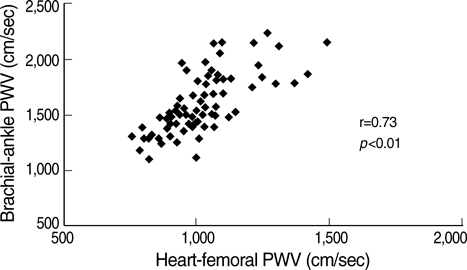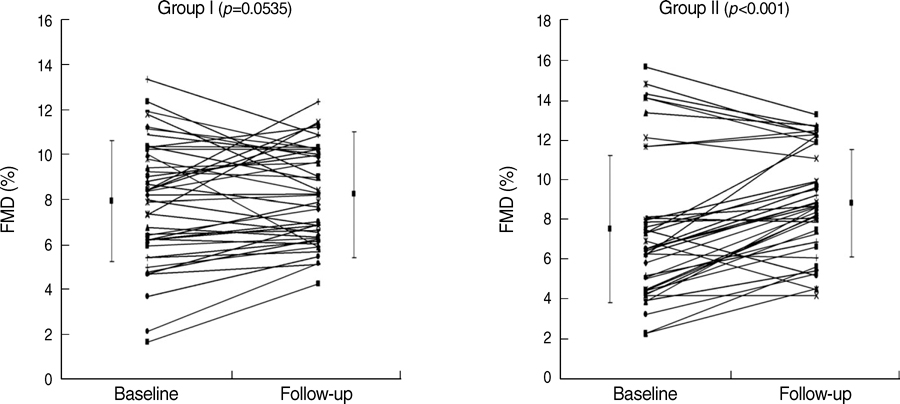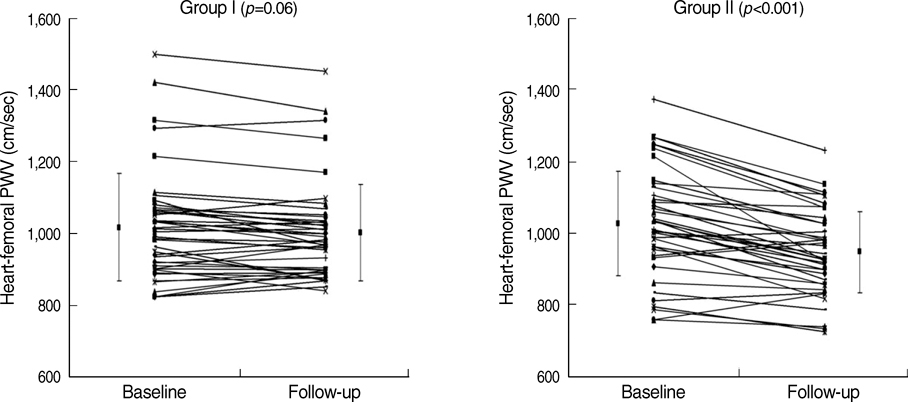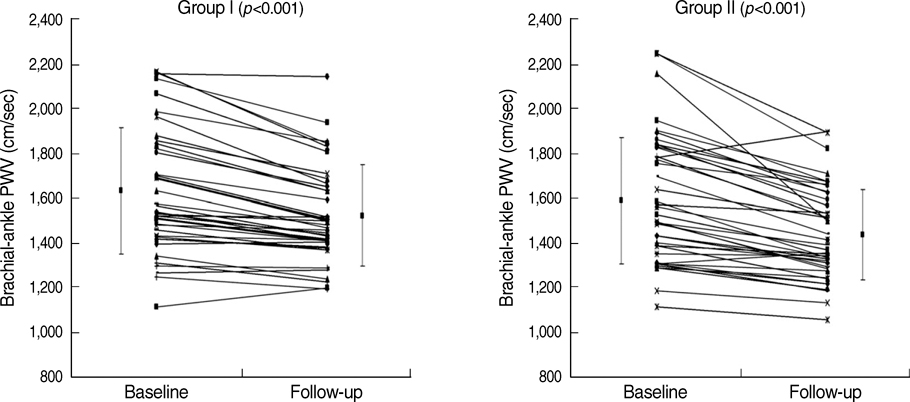Clinical Effects of Calcium Channel Blocker and Angiotensin Converting Enzyme Inhibitor on Endothelial Function and Arterial Stiffness in Patients with Angina Pectoris
- Affiliations
-
- 1The Heart Center of Chonnam National University Hospital, Gwangju, Korea. myungho@chollian.net
- KMID: 1779122
- DOI: http://doi.org/10.3346/jkms.2009.24.2.223
Abstract
- To evaluate the effects of calcium channel blocker (CCB) and angiotensin converting enzyme inhibitor (ACEI) on endothelial function and arterial stiffness in stable angina pectoris (SAP), 87 patients with SAP (57.6+/-10.0 yr, 52 males) were divided into two groups; CCB group (group I: n=44, 57.9+/-9.7 yr, 23 males) vs. CCB plus ACEI group (group II: n=43, 57.2+/-10.5 yr, 29 males). Flow mediated vasodilation (FMD) of the brachial artery, pulse wave velocity (PWV), urinary albumin excretion (UAE), and high sensitivity C-reactive protein (hsCRP) were compared. FMD, PWV, UAE, and hsCRP were not different between the groups at baseline. After 6 months of treatment, FMD were significantly improved in group II (7.5+/-3.7 to 8.8+/-2.7%, p<0.001), but not in group I (7.9+/-2.7 to 8.2+/-2.8%, p=0.535). Brachial-ankle PWV were significantly improved in both groups (1,621.3+/-279.4 to 1,512.1+/-225.0 cm/sec in group I, p<0.001, 1,586.8+/-278.5 to 1,434.5+/-200.5 cm/sec in group II, p<0.001). However, heart-femoral PWV were significantly improved (1,025.7+/-145.1 to 946.2+/-112.2 cm/sec, p<0.001) and UAE were significantly decreased (20.19+/-29.92 to 13.03+/-16.42 mg/g Cr, p=0.019) in group II only. In conclusion, combination therapy with CCB and ACEI improves endothelial function, arterial stiffness, and UAE than CCB mono-therapy more effectively in patients with SAP.
MeSH Terms
-
Aged
Angina Pectoris/*drug therapy
Angiotensin-Converting Enzyme Inhibitors/*therapeutic use
Arteries/*physiopathology
Blood Flow Velocity/physiology
Brachial Artery/drug effects/physiopathology
Calcium Channel Blockers/*therapeutic use
Drug Therapy, Combination
Endothelium, Vascular/drug effects/*physiopathology
Humans
Male
Middle Aged
Vasodilation/drug effects
Figure
Cited by 2 articles
-
Effects of Low Dose versus High Dose Statin Therapy on the Changes of Endothelial Function and Carotid Intima-Media Thickness in Patients with Variant Angina
Kye Hun Kim, Sook Hee Cho, Yi Rang Yim, Kyung Jin Lee, Ju Hyup Yum, Hyun Ju Yoon, Nam Sik Yoon, Young Joon Hong, Hyung Wook Park, Ju Han Kim, Youngkeun Ahn, Myung Ho Jeong, Jeong Gwan Cho, Jong Chun Park
J Cardiovasc Ultrasound. 2013;21(2):58-63. doi: 10.4250/jcu.2013.21.2.58.The Phase 4 Randomized, Public, Parallel, Comparative, Clinical Trial to Compare Efficacy and Safety of S-(-)-Amlodipine Nicotinate with Ramipril in Hypertensive Patients
Min Suk Kim, Myung Ho Jeong, Min Goo Lee, Doo Sun Sim, Keun-Ho Park, Nam Sik Yoon, Hyun Ju Yoon, Kye Hun Kim, Young Joon Hong, Ju Han Kim, Young Keun Ahn, Jeong Gwan Cho, Jong Chun Park, Jung Chaee Kang
J Korean Soc Hypertens. 2011;17(3):103-113. doi: 10.5646/jksh.2011.17.3.103.
Reference
-
1. Anderson KM, Odell PM, Wilson PW, Kannel WB. Cardiovascular disease risk profiles. Am Heart J. 1991. 121:293–298.
Article2. Grundy SM, Pasternak R, Greenland P, Smith S Jr, Fuster V. Assessment of cardiovascular risk by use of multiple-risk-factor assessment equations: a statement for healthcare professionals from the American Heart Association and the American College of Cardiology. Circulation. 1999. 100:1481–1492.3. Patel SN, Rajaram V, Pandya S, Fiedler BM, Bai CJ, Neems R, Feinstein M, Goldin M, Feinsetin SB. Emerging, noninvasive surrogate markers of atherosclerosis. Curr Atheroscler Rep. 2004. 6:60–68.
Article4. Ross R. The pathogenesis of atherosclerosis: a perspective for the 1990s. Nature. 1993. 362:801–809.
Article5. Gibbons GH. Endothelial function as a determinants of vascular function and structure: a new therapeutic target. Am J Cardiol. 1997. 79:3–8.6. Selwyn AP, Kinlay S, Creager M, Libby P, Ganz P. Cell dysfunction in atherosclerosis and the ischemic manifestations of coronary artery disease. Am J Cardiol. 1997. 79:17–23.
Article7. Corretti MC, Anderson TJ, Benjamin EJ, Celermajer D, Charbonneau F, Creager MA, Deanfield J, Drexler H, Gerhard-Herman M, Herrington D, Vallance P, Vita J, Vogel R. International Brachial Artery Reactivity Task Force. Guidelines for the ultrasound assessment of endothelial dependent flow mediated vasodilation of the brachial artery: a report of the International Brachial Artery Reactivity Task Force. J Am Coll Cardiol. 2002. 39:257–265.8. Izzo JL, Shykoff BE. Arterial stiffness: clinical relevance, measurement, and treatment. Rev Cardiovasc Med. 2001. 2:29–40.9. Lagrand WK, Visser CA, Hermens WT, Niessen HW, Verheugt FW, Wolbink GJ, Hack CE. C-reactive protein as a cardiovascular risk factor: more than an epiphenomenon? Circulation. 1999. 100:96–102.10. Ridker PM, Rifai N, Rose L, Buring JE, Cook NR. Comparison of C-reactive protein and low-density lipoprotein cholesterol levels in the prediction of first cardiovascular events. N Engl J Med. 2002. 347:1557–1565.
Article11. Luft FC, Agrawal B. Microalbuminuria as a predictive factor for cardiovascular events. J Cardiovasc Pharmacol. 1999. 33:Suppl 1. S11–S15. discussion S41-43.
Article12. Sukhija R, Aronow WS, Kakar P, Garza L, Sachdeva R, Sinha A, Mehta JL. Relation of microalbuminuria and coronary artery disease in patients with and without diabetes mellitus. Am J Cardiol. 2006. 98:279–281.
Article13. Bonetti PO, Lerman LO, Lerman A. Endothelial dysfunction: a marker of atherosclerotic risk. Arterioscler Thromb Vasc Biol. 2003. 23:168–175.14. Mahmud A, Feely J. Antihypertensive drugs and arterial stiffness. Expert Rev Cardiovasc Ther. 2003. 1:65–78.
Article15. Gibbons RJ, Abrams J, Chatterjee K, Daley J, Deedwania PC, Douglas JS, Ferguson TB Jr, Fihn SD, Fraker TD Jr, Gardin JM, O'Rourke RA, Pasternak RC, Williams SV, Gibbons RJ, Alpert JS, Antman EM, Hiratzka LF, Fuster V, Faxon DP, Gregoratos G, Jacobs AK, Smith SC Jr. American College of Cardiology. American Heart Association Task Force on Practice Guidelines. Committee on the Management of Patients with Chronic Stable Angina. ACC/AHA 2002 guideline update for the management of patients with chronic stable angina: a report of the American College of Cardiology/American Heart Association Task Force on Practice Guidelines. Circulation. 2003. 107:149–158.16. Kitta Y, Nakamura T, Kodama Y, Takano H, Umetani K, Fujioka D, Saito Y, Kawabata K, Obata JE, Ichiqi Y, Mende A, Kuqiyama K. Endothelial vasomotor dysfunction in the brachial artery is associated with late in-stent coronary restenosis. J Am Coll Cardiol. 2005. 46:648–655.
Article17. Patti G, Pasceri V, Melfi R, Goffredo C, Chello M, D'Ambrosio A, Montesanti R, Di Sciascio G. Impaired flow-mediated dilation and risk of restenosis in patients undergoing coronary stent implantation. Circulation. 2005. 111:70–75.
Article18. Mancini GB, Henry GC, Macaya C, O'Neill BJ, Pucillo AL, Carere RG, Wargovich TJ, Luscher TF, Klibaner MI, Haber HE, Uprichard AC, Pepine CJ, Pitt B. Angiotensin-converting enzyme inhibition with quinapril improves endothelial vasomotor dysfunction in patients with coronary artery disease. The TREND (Trial on Reversing ENdothelial Dysfunction) Study. Circulation. 1996. 94:258–265.19. Anderson TJ, Elstein E, Haber H, Charbonneau F. Comparative study of ACE-inhibition, angiotensin II antagonism, and calcium channel blockade on flow-mediated vasodilation in patients with coronary disease (BANFF study). J Am Coll Cardiol. 2000. 35:60–66.
Article20. van Popele NM, Grobbee DE, Bots ML, Asmar R, Topouchian J, Reneman RS, Hoeks AP, van der Kuip DA, Hofman A, Witteman JC. Association between arterial stiffness and atherosclerosis: the Rotterdam Study. Stroke. 2001. 32:454–460.21. London GM, Marchais SJ, Guerin AP, Pannier B. Arterial stiffness: pathophysiology and clinical impact. Clin Exp Hypertens. 2004. 26:689–699.
Article22. Weber T, Auer J, O'Rourke MF, Kvas E, Lassnig E, Berent R, Eber B. Arterial stiffness, wave reflections, and the risk of coronary artery disease. Circulation. 2004. 109:184–189.
Article23. Imanishi R, Seto S, Toda G, Yoshida M, Ohtsuru A, Koide Y, Baba T, Yano K. High brachial-ankle pulse wave velocity is an independent predictor of the presence of coronary artery disease in men. Hypertens Res. 2004. 27:71–78.
Article24. Chirinos JA, Zambrano JP, Chakko S, Veerani A, Schob A, Willens HJ, Perez G, Mendez AJ. Aortic pressure augmentation predicts adverse cardiovascular events in patients with established coronary artery disease. Hypertension. 2005. 45:980–985.
Article25. Nigam A, Mitchell GF, Lambert J, Tardif JC. Relation between conduit vessel stiffness (assessed by tonometry) and endothelial function (assessed by flow-mediated dilatation) in patients with and without coronary heart disease. Am J Cardiol. 2003. 92:395–399.
Article26. Kobayashi K, Akishita M, Yu W, Hashimoto M, Ohni M, Toba K. Interrelationship between noninvasive measurements of atherosclerosis: flow-mediated dilation of brachial artery, carotid intima-media thickness and pulse wave velocity. Atherosclerosis. 2004. 173:13–18.
Article27. Morgan T, Lauri J, Bertram T, Anderson A. Effect of different antihypertensive drug classes on central aortic pressure. Am J Hypertens. 2004. 17:118–123.
Article28. Fichtlscherer S, Rosenberger G, Walter DH, Breuer S, Dimmeler S, Zeiher AM. Elevated C-reactive protein levels and impaired endothelial vasoreactivity in patients with coronary artery disease. Circulation. 2000. 102:1000–1006.
Article29. Nagano M, Nakamura M, Sato K, Tanaka F, Segawa T, Hiramori K. Association between serum C-reactive protein levels and pulse wave velocity: a population-based cross-sectional study in a general population. Atherosclerosis. 2005. 180:189–195.
Article30. Tsioufis C, Dimitriadis K, Taxiarchou E, Vasiliadou C, Chartzoulakis G, Tousoulis D, Manolis A, Stefanadis C, Kallikazaros I. Diverse associations of microalbuminuria with C-reactive protein, interleukin 18 and soluble CD 40 ligand in male essential hypertensive subjects. Am J Hypertens. 2006. 19:462–466.31. Vitale C, Cerquetani E, Wajngarten M, Leonardo F, Silvestri A, Mercuro G, Fini M, Ramires JA, Rosano GM. In patients with coronary artery disease endothelial function is associated with plasma levels of C-reactive protein and is improved by optimal medical therapy. Ital Heart J. 2003. 4:627–632.32. Yufu K, Takahashi N, Hara M, Saikawa T, Yoshimatsu H. Measurement of the brachial-ankle pulse wave velocity and flow-mediated dilatation in young, healthy smokers. Hypertens Res. 2007. 30:607–612.
Article33. Cohn JN, Quyyumi AA, Hollenberg NK, Jamerson KA. Surrogate markers for cardiovascular disease: functional markers. Circulation. 2004. 109:IV31–IV46.
Article34. Jerums G, MacIsaac RJ. Treatment of microalbuminuria in patients with type 2 diabetes mellitus. Treat Endocrinol. 2002. 1:163–173.
Article35. Morimoto S, Yano Y, Maki K, Iwasaka T. Renal and vascular protective effects of cilnidipine in patients with essential hypertension. J Hypertens. 2007. 25:2178–2183.
Article
- Full Text Links
- Actions
-
Cited
- CITED
-
- Close
- Share
- Similar articles
-
- A Case of Angiotensin Converting Enzyme Inhibitor-Induced Systemic Lupus Erythematosus
- Selection of Antihypertensive Drugs in Hypertensive Patients with Diabetes Mellitus: In Pohang-Gyeongju Primary Care Research Network
- Effect of Angiotensin Converting Enzyme Inhibitors on Induced Angiotensin Converting Enzyme Activity in Rat Intestine
- Effects of Angiotensin-Converting Enzyme Inhibitor on Arterial Stiffness, Diastolic Function, and Exercise Performance in Patients with Hypertension
- Therapeutic Effect of Nicorandil on Angina Pectoris






